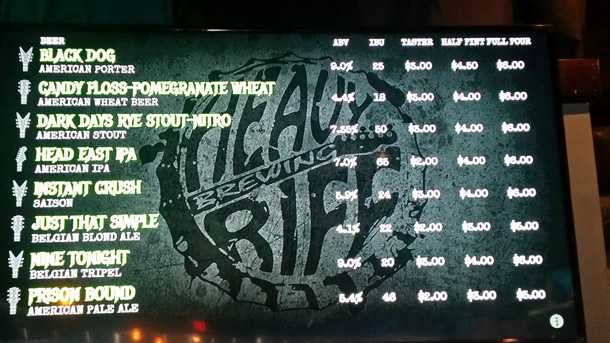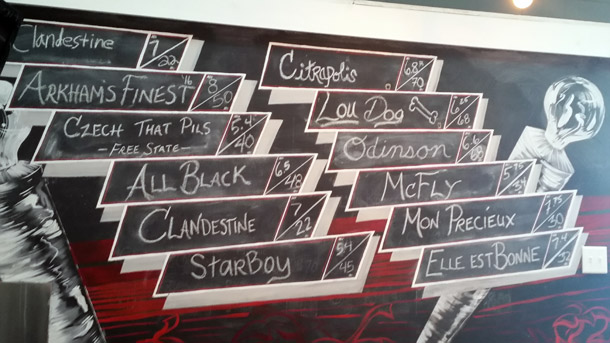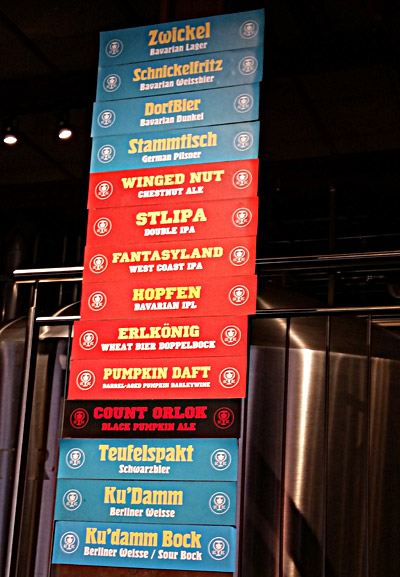Yesterday Jeff Alworth filed a dispatch from Bend, Oregon, headlined “American Palates: 82% IPA.” He reported a definite lack of diversity at the brewery taprooms he visited, leading him to write, “The point of all this? Hoppy ales have taken over American brewing, and we’re never going back.” And, “When a country develops its own beer culture, diversity declines.”
Perhaps this means Oregon is more advanced than we are here in the Midwest, because we have not yet developed a similar beer monoculture. (The caveat being, as Alworth points otu, that we are talking about everything outside of industrial pale lagers.) To make reassure myself I’ve rounded up what’s on offer at six of the seven breweries within two and a half miles of our house.
I’m not saying where we live (near that small green park left of central on the map) is typical of St. Louis, Missouri, the Midwest, whatever; just telling you what’s nearby. That Twitter asks if it should translate the menu board at Side Project Brewing from French or tweets from Urban Chestnut Brewing from German may be a sign we don’t fit in quite anywhere.

Urban Chestnut (on the right) is located three and a half miles from Side Project (on the left). Between them, reading left to right, are Schlafly Bottleworks, Heavy Riff Brewery, 2nd Shift Brewing and Modern Brewery. Urban Chestnut also operate its Urban Research Brewery across the street from the one marked here. URB is in a separate building and has its own brewing license, but the small system it not yet up and running.

Side Project is only open on weekends. This is what was on tap last Saturday. Zero IPAs.

Schlafly has 15 beers and a cider on tap. The board with the list is not particularly exciting, so here are taps in the education/store area (across from the interactive beer wall). The draft list includes three IPAs, one of them black — the first in a series of IPAs that will include eight beers featuring 12 hops, nine farms and three countries.

Heavy Riff can only display half of its draft menu at a time, but yesterday there were 15 beers on tap. There was one IPA (cloudy and New England style, in fact), a hop-forward pale ale (also East Coast style) and a session wheat beer flush with New World hops. The other 12 (80 percent of the choices) included its flagship American brown, with with roasted oats and lactose, a porter, a stout, Belgian-inspired beers, an Irish Red, a British pale, and more. Kind of a United Nations of beer.

2nd Shift posts an updated beer menu everyday but Monday (when the brewery is closed). Here is Sunday’s list, and yes, four of the ten 2nd Shift beers on tap are IPAs.

Modern is open only on the weekends. This is what will pouring when they open Friday, including two IPAs (Citropolis and Odinson).
 Not everything Urban Chestnut is pouring fits in one place. Of the 21 beers listed two are IPAs. Only two are pilsners, but that should change soon. The beers are members of two families, Revolution (red) and Reverence (blue).
Not everything Urban Chestnut is pouring fits in one place. Of the 21 beers listed two are IPAs. Only two are pilsners, but that should change soon. The beers are members of two families, Revolution (red) and Reverence (blue).
Final tally: 86 taps, 12 IPAs (14%).
My Chicago-area and Vermont and Wisconsin and Colorado experiences are closer to yours than to Jeff’s. I think he might have a point when it comes to buying beer in supermarkets and restaurants and such, though I also wonder if its too early to say — he makes a big deal about the rise of IPAs and similar taste-hoppy beers in best of lists from ten years back and today, but maybe it behooves us to wait another ten years to see if it zags again? But if the early days of what I guess we no longer call the craft movement meant variety, i still see that variety in brewpubs, taprooms and specialty beer bars. Chicago has lots of breweries these days, and many recent ones have decided they don’t need to compete with the hop-forward beers from the last couple of generations of Chicago-breweries, so they brew other styles.
A good reality check. Be interesting to hear from other parts of the country.
I do still more or less stick with my basic point–I think the US is headed (within the craft segment) ever more toward hops. Taplists have generally concealed the dominance of IPA more than demonstrate it; when I’ve asked brewers what volume is IPA–irrespective of their line’s diversity–it is often a high percentage (and ticking up). What was so striking about my experience was how it seemed breweries were finally just letting their offerings reflect customer preference.
What *was* interesting was looking at Worthy’s IPAs. Among their vast offerings, they had managed to make quite a range of different types of hoppy ales. That seems to be the future of diversity–within the category.
To be clear, I love IPAs and I love American hops. The last 4 beers I’ve ordered out in the wild were IPAs (OK, a short streak, but a streak). And I agree that there are plenty more hop-forward beers on the horizon.
But it sure looks to me like there is room for diversity, which can take many different forms, hop-focused and otherwise. I have no idea what this means for the future, but I will pass it along. Last week when I was talking to a brewer on the East Coast who makes very popular cloudy IPAs he said, “These are yeast driven beers.”
“These are yeast driven beers.”
Oh good lord.
I’ve done this sort of analysis in the past, but on a much more micro-level around the Philadelphia region. If you’re up for a nationwide project and need a regional like-minded person to pull data together, I’ll throw my hat in as the northeast/mid-atlantic guy. Could definitely produce some interesting, maybe surprising, results. I might envision a color-coded heat map to illustrate the differences.
“Yeast-driven beers.”
Chef-driven menus. Brewer-driven beers?
Don’t forget profit-drive beers.